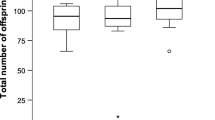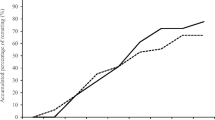Abstract
Female mating with multiple males in a single reproductive period, or polyandry, is a common phenomenon in animals. In this study we investigated variation in female mating behavior and its fitness consequences among three genetic strains of the red flour beetle, Tribolium castaneum. We found that the extent of polyandry and its fitness consequences varied significantly among the strains. In the first strain PRUZ, females mated multiply but incurred costs of polyandry in the form of reduced offspring production. Females of the second strain, NDG11, mated readily with multiple partners and benefited because polyandry led to higher offspring quality. Finally, TIW1 females were resistant to multiple mating and polyandry resulted in lower offspring production but improved offspring quality. Thus, in the first population we observed only costs of polyandry, in the second strain only benefits of polyandry whereas in the third we detected both costs and benefits of polyandry. Possible explanations for such a pattern are discussed.


Similar content being viewed by others
References
Andersson M (1994) Sexual selection. Princeton University Press, Princeton
Andres JA, Arnqvist G (2001) Genetic divergence of the seminal signal-receptor system in houseflies: the footprints of sexually antagonistic coevolution? Proc Roy Soc Lond B 268:399–405
Arnaud L, Haubruge E, Gage MJG (2001) Sperm size and number variation in the red flour beetle. Zool J Linn Soc 133:369–375
Arnqvist G, Edvardsson M, Friberg U, Nilsson T (2000) Sexual conflict promotes speciation in insects. P Natl Acad Sci USA 97:10460–10464
Arnqvist G, Nilsson T (2000) The evolution of polyandry: multiple mating and female fitness in insects. Anim Behav 60:145–164
Arnqvist G, Rowe L (2002) Antagonistic coevolution between the sexes in a group of insects. Nature 415:787–789
Attia FA,Tregenza T (2004) Divergence revealed by population crosses in the red flour beetle Tribolium castaneum. Evol Ecol Res 6:927–935
Baer B, Schmid-Hempel P (1999) Experimental variation in polyandry affects parasite loads and fitness in a bumble-bee. Nature 397:151–154
Baer B, Schmid-Hempel P (2001) Unexpected consequences of polyandry for parasitism and fitness in the bumblebee, Bombus terrestris. Evolution 55:1639–1643
Beeman RW, Thomson MS, Clark JM, DeCamillis MA, Brown SJ, Denell RE (1996) Woot, an active gypsy-class retrotransposon in the flour beetle, Tribolium castaneum, is associated with a recent mutation. Genetics 143:417–426
Beeman R, Brown S (1999) RAPD-based genetic linkage maps of Tribolium castaenum. Genetics 153:333–338
Bernasconi G, Keller L (2001) Female polyandry affects son’s reproductive success in the red flour beetle Tribolium castaneum. J Evol Biol 14:186–193
Birkhead T (2000) Promiscuity: an evolutionary history of sperm competition. Harvard University, Cambridge
Boake C, Wade M (1984) Populations of red flour beetle Tribolium castaneum (Coleoptera: Tenebrionidae) differ in their sensitivity to aggregation pheromones. Environ Entomol 13:1182–1185
Boughman JW (2001) Divergent sexual selection enhances reproductive isolation in sticklebacks. Nature 411:944–948
Brooker M, Rowley I, Adams M, Baverstock P (1990) Promiscuity: an inbreeding avoidance mechanism in a socially monogamous species? Behav Ecol Sociobiol 26:191–199
Brown DV, Eady PE (2001) Functional incompatibility between the fertilization systems of two allopatric populations of Callosobruchus maculatus (Coleoptera: Bruchidae). Evolution 55:2257–2262
Chapman T, Arnqvist G, Bangham J, Rowe L (2003) Sexual conflict. Tr Ecol Evol 18:41–47
Clark A, Begun D, Prout T (1999) Female X male interactions in Drosophila sperm competition. Science 283:217–220
Drummond B (1984) Multiple mating and sperm competition in the Lepidoptera. In: Smith RL (ed) Sperm competition and the evolution of animal mating strategies. Academic Press Orlando, FL, pp 291–370
Eady PE, Wilson N, Jackson M (2000) Copulating with multiple mates enhances female fecundity but not egg-to-adult survival in the bruchid beetle Callosobruchus maculatus. Evolution 54:2161–2165
Eberhard W (1996) Female control: sexual selection by cryptic female choice. Princeton University Press, Princeton
Endler JA, Houde AE (1995) Geographic variation in female preferences for male traits in Poecilia reticulata. Evolution 49:456–468
Evans JP, Magurran AE (2000) Multiple benefits of multiple mating in guppies. P Natl Acad Sci USA 97:10074–10076
Gavrilets S, Arnqvist G, Friberg U (2001) The evolution of female mate choice by sexual conflict. Proc Roy Soc Lond B 268:531–539
Gilburn A, Day T (1994) Evolution of female choice in seaweed flies: fisherian and good genes mechanisms operate in different populations. Proc Roy Soc Lond B 255:159–165
Gray DA, Cade WH (2000) Sexual selection and speciation in field crickets. P Natl Acad Sci USA 97:14449–14454
Harano T, Miyatake T (2005) Heritable variation in polyandry in Callosobruchus chinensis. Anim Behav 70:299–304
Härdling R, Kaitala A (2005) The evolution of repeated mating under sexual conflict. J Evol Biol 18:106–115
Holland B, Rice W (1999) Experimental removal of sexual selection reverses intersexual antagonistic coevolution and removes reproductive load. P Natl Acad Sci USA 96:5083–5088
Hosken DJ, Garner TWJ, Ward PI (2001) Sexual conflict selects for male and female reproductive characters. Curr Biol 11:489–493
Jennions M, Petrie M (1997) Variation in mate choice and mating preferences: a review of causes and consequences. Biol Rev 72:283–327
Jennions MD, Petrie M (2000) Why do females mate multiply? A review of the genetic benefits. Biol Rev 75:21–64
Konior M, Radwan J, Kolodziejczyk M (2001) Polyandry increases offspring fecundity in the bulb mite. Evolution 55:1893–1896
Kwiatkowski MA, Sullivan BK (2002) Geographic variation in sexual selection among populations of an iguanid lizard, Sauromalus obesus (=ater). Evolution 56:2039–2051
Lesna I, Sabelis MW (1999) Diet-dependent female choice for males with `good genes’ in a soil predatory mite. Nature 401:581–584
Magurran AE, Seghers BH (1994) Sexual conflict as a consequence of ecology: evidence from Guppy, Poecilia reticulata, populations in Trinidad. Proc Roy Soc Lond B 255:31–36
Masta SE, Maddison WP (2002) Sexual selection driving diversification in jumping spiders. P Natl Acad Sci USA 99:4442–4447
Nilsson T, Fricke C, Arnqvist G (2002) Patterns of divergence in the effects of mating on female reproductive performance in flour beetles. Evolution 56:111–120
Nilsson T, Fricke C, Arnqvist G (2003) The effects of male and female genotype on variance in male fertilization success in the red flour beetle (Tribolium castaneum). Behav Ecol Sociobiol 53:227–233
Olsson M, Madsen T, Shine R, Gullberg A, Tegelstrom H (1994) Rewards of promiscuity. Nature 372:229–230
Olsson M, Shine R, Madsen T, Gullberg A, Tegelstrom H (1996) Sperm selection by females. Nature 383:585
Orsetti DM, Rutowski RL (2003) No material benefits, and a fertilization cost, for multiple mating by female leaf beetles. Anim Behav 66:477–484
Pai A, Yan G (2002a) Polyandry produces sexy sons at the cost of daughters in red flour beetles. Proc Roy Soc Lond B 269:361–368
Pai A, Yan G (2002b) Female mate choice in relation to heterozygosity in Tribolium castaneum. J Evol Biol 15:1076–1082
Pai A, Yan G (2003) Rapid female multiple mating in red flour beetles (Tribolium castaneum). Can J Zoo 81:888–896
Pai A, Bennett L, Yan G (2005) Female multiple mating for fertility assurance in red flour beetles? Can J Zool 83:913–919
Parker GA, Partridge L (1998) Sexual conflict and speciation. Philos T Roy Soc B 353:261–274
Rice WR (1996) Sexually antagonistic male adaptation triggered by experimental arrest of female evolution. Nature 381:232–234
Ridley M (1988) Mating frequency and fecundity in insects. Biol Rev Cambr Phil Soc 63:509–549
SAS (1995) JMP statistics and graphics guide. SAS Institute, Cary
Stockley P, Searle JB, MacDonald DW, Jones CS (1993) Female multiple mating behaviour in the common shrew as a strategy to reduce inbreeding. Proc Roy Soc Lond B 254:173–179
Ting C-T, Takahashi A, Wu C-I (2001) Incipient speciation by sexual isolation in Drosophila: concurrent evolution at multiple loci. P Natl Acad Sci USA 98:6709–6713
Uy JAC, Borgia G (2000) Sexual selection drives rapid divergence in bowerbird display traits. Evolution 54:273–278
Wade MJ (1977) An experimental study of group selection. Evolution 31:134–153
Wu C, Hollocher H, Begun D, Aquadaro C, Xu Y, Wu M (1995) Sexual isolation in Drosophila melanogaster: a possible case of incipient speciation. P Natl Acad Sci USA 92:2519–2523
Yan G, Stevens L (1995) Selection by parasites on components of fitness in Tribolium beetles: the effect of intraspecific competition. Am Nat 146:795–813
Zeh JA, Zeh DW (1996) The evolution of polyandry I: intragenomic conflict and genetic incompatibility. Proc Roy Soc Lond B 263:1711–1717
Acknowledgments
We thank C. Kane, T. Cottom, G. Bajwa, M. Park, and K. Tran for technical assistance. A. Monteiro and anonymous reviewers provided useful suggestions on improving the manuscript. The research is supported by National Science Foundation grant IBN 1030165. These experiments comply with the current laws of the country they were conducted in.
Author information
Authors and Affiliations
Corresponding author
Rights and permissions
About this article
Cite this article
Pai, A., Feil, S. & Yan, G. Variation in polyandry and its fitness consequences among populations of the red flour beetle, Tribolium castaneum . Evol Ecol 21, 687–702 (2007). https://doi.org/10.1007/s10682-006-9146-4
Received:
Accepted:
Published:
Issue Date:
DOI: https://doi.org/10.1007/s10682-006-9146-4




